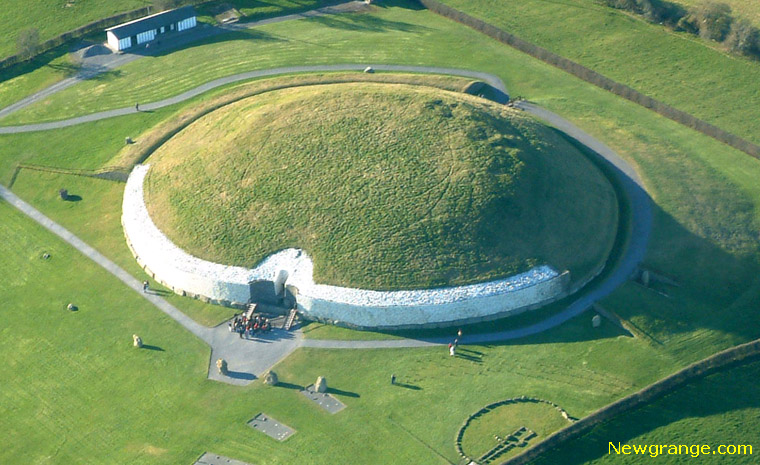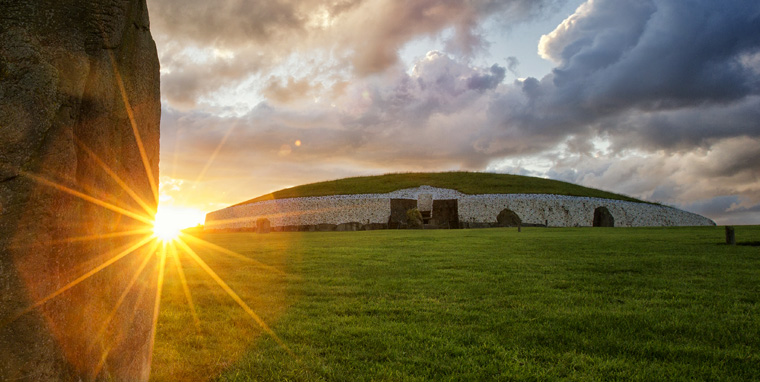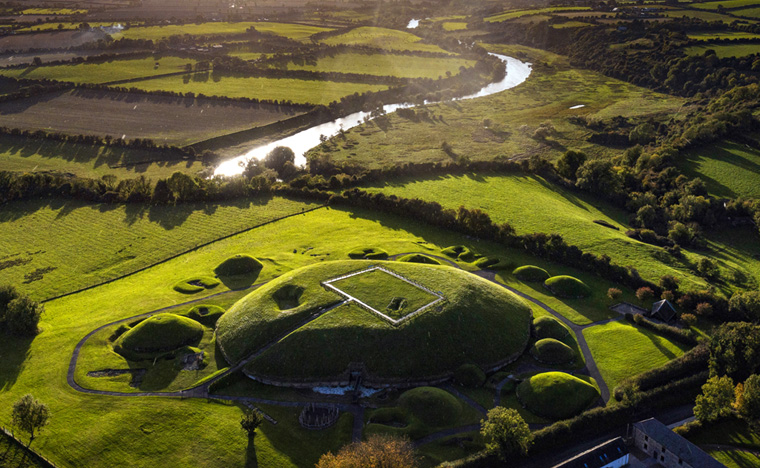The Irish Origins of the European Megalithic Culture

Newgrange Megalithic Passage Tomb located in the Boyne Valley, Ireland
Dating the monuments:
There are three main ways in which archaeologists date megalithic structures. At present, the most direct and accurate method being radiocarbon dating, or carbon-14 dating. It is not possible to carbon date the stone of the structures themselves as this technique can only be applied to organic materials, with regards to megalithic sites this usually involves wood, bone or charcoal found in and around the structure. Radiocarbon dating can effectively date material up to 50,000 years old. Recent developments in radiocarbon dating, such as Accelerator Mass Spectrometry (A.M.S), have allowed for a greater deal of precision when dating materials.Less direct methods of dating include examination of artefact typologies present inside the structure, or assessment of the tomb typologies themselves. Assessment of tomb or artefact typologies however, are based on questionable assumptions and should not be viewed as a very reliable source of dating.
Radiocarbon dating works by measuring the concentration of the isotope C14, which is contained in all organic materials. Since the rate of decay of C14 is a known constant, it is possible to determine within a certain degree of accuracy the age of the material in question. Radiocarbon dating has had a greater influence on archaeology than any other technological advance in the field, especially with regards to periods of prehistory where, without written records, archaeologists could previously only speculate the age of sites. Before it was developed archaeologists dated sites largely by guesswork and assuming connections with other artefacts, the discovery of radiocarbon dating has proven that many previously held beliefs of historical development were simply wrong. Many radiocarbon results were so unexpected that archaeologists initially questioned the accuracy of the method, however, with time, the reliability of radiocarbon dating has been established.
Western European Origins:
The advent of radiocarbon dating has forced archaeologists to re-think the entire the chronology of western European megalithic culture. Prior to radiocarbon dating, it had been believed that megalithic culture had been brought to western Europe from the Mediterranean region, however, this was proven to be utterly false when C14 dating methods showed that the megalithic sites of western Europe substantially predated those of the Mediterranean. Not only that, but the monuments of western Europe were found to predate those of Egypt and the Near Eastern cultures also, which had previously been thought to have been the inspiration for the European megalithic builders.The earliest dates of construction for western European megaliths are found to be in the west of Ireland. These early dates were first put forth in the late 1970's early 1980's by a group of Swedish archaeologists led by Stefan Bergh excavating in and around the Carrowmore megalithic complex. Initially, the very early carbon dates produced were met with some scepticism. The accuracy of Swedish teams findings were questioned as they seemed to shatter preconceived notions of the progression of megalith building in Europe. With time however, the megalithic sites of western Ireland have been proven to indeed be the oldest such sites in Europe.
Swedish archaeologist Goran Burenhult returned to Carrowmore from 1994 - 1998 in the hope of confirming or disproving the dates which had been put forth in the 1970's and 80's. This time however, with the aid of Accelerator Mass Spectrometry (A.M.S), more precise dates could be obtained. Radiocarbon evidence from the new excavations strongly support the findings of the previous campaign. The oldest dates from the Carrowmore complex come from Tomb no. 4. A sample taken from the foundation sockets of the stones in the cist have indicated a date of 5400 BC. Beyond this the oldest cists elsewhere in Europe are to be found at the so called Chamblandes cists of Switzerland and French Jura, giving a C14 date indicating an age range between 4800 - 3300 BC.
Just beyond Carrowmore two other sites in western Ireland have produced even earlier dates. Croaghaun in the Ox Mountains, has produced a date going back as far as 5600 BC from samples of charcoal found in the central chamber. Samples taken from a stone socket in Primrose Grange Tomb 1, have yielded a date of 6400 BC. Taken on their own, these extremely early dates for megalithic activity in Ireland are sure to draw scepticism, it should be noted by the sceptic however, that five dates from three different tombs point to activity on these sites between 6400 and 4600 BC, far earlier than anywhere else in Europe.
These very early dates prove that the practice of constructing megalithic monuments in Ireland began on the west coast. This culture thrived over the next few thousand years, with the monuments growing in complexity and reaching a peak with the awe inspiring monuments of the Boyne Valley from 3500 BC. Furthermore, these early dates prove that the megalithic culture of Ireland is the oldest in Europe, and so it should not be assumed that the culture was brought to Ireland from Britain or the European mainland, on the contrary, these findings would seem to suggest that the megalithic culture was developed in Ireland and that the practice was carried out from Ireland onto the continent. Not only is this theory supported by the radiocarbon dates being produced by archaeologists, but stepping outside the field of archaeology, a study of the evolution of archaeoastronomy and astrotheology confirm this.
It is this obligation to step outside the purely physical remnants, and into the realm of comparative mythology, calendar systems, iconography and ritual which critically hinders archaeologists attempts to paint a coherent picture of pre-history. Whereas archaeologists will deal only with the physical artefacts, it is absolutely necessary to bring together these seemingly separate fields of study to see how this culture evolved and influenced other civilizations throughout the world. The over-compartmentalization of historical matters has led to a fragmented view of pre-history, and it is only now with rapidly growing access to all streams of information that this problem is being remedied.
The European Megalithic Culture:
One of the most striking features of the European megalithic monuments, is the fact that they simply do not appear in any greatly significant concentrations on the European mainland, instead the great civic centres of the European megalithic culture are to be found huddled along the Atlantic seaboard, primarily in Ireland, Britain and Brittany. When this fact is coupled with the extremely early carbon 14 dates obtained in the west of Ireland, dates which make them the oldest such structures in the world, this gives a very clear indication that Ireland was the source of the megalithic building culture.Further proof of this is the extremely high concentrations of megalithic artwork found upon Irish shores. The Boyne Valley in Ireland contains over 60% of all Europe's megalithic art, with the great Neolithic temple of Knowth containing more than a quarter of Europe's entire collection, making Knowth the absolute centre of European megalithic art. In stark comparison, only a mere six British sites feature even the slightest trace of megalithic artwork. This highlights the Boyne Valley's status as a spiritual centre for the European megalithic religion. At its peak, Knowth would have been considered the Cistine Chapel of the ancient religion. Archaeological evidence has shown that people made pilgrimages to Knowth from all over Europe.
Many of the myths and legends that surround European megalithic sites support the theory that Ireland was the source of this culture. Throughout the early literature a special regard is attributed to all things associated with Ireland. Early mention of Stonehenge was made in 1135 by chronicler Geoffrey of Monmouth, who claimed that that the monument was flown by the wizard Merlin across the sea from Ireland. Another legend claims that the stones were stolen from an Irish woman by the Devil, and re-erected on Salisbury Plain by Merlin for Ambrosius Aurelianus, the King of Britons.
This shows why Ireland was considered a holy or sacred island all throughout the ancient world. It is referred to by many names throughout the ancient texts, the sacred isle, the blessed isle, the land of saints and scholars, all of these names took root because of Irelands position as the spiritual centre of Europe's Neolithic people. The entire island was thought to be an astronomical temple. The tradition of Druidry, which surely descended from the Neolithic tradition, was held in very high esteem throughout Ancient Greece and Rome. Even the great Pythagoras was said to have been thought by the druid, Abaris.
The Lia Fail, the ancient coronation stone of Irish kings once housed at Tara in Co. Meath is further proof of Ireland's importance to adherents of the ancient religion. It is said that the stone was taken from Ireland to Scotland around 513 AD so that Fergus may be crowned King of Scotland on it. It was later transferred to the Abbey of Scone in Perth and remained there for centuries as the inaugural stone of Scottish Kings. Sometime around 1300, English King Edward I stole the Lia Fail, and brought it to London where it was placed under the throne in Westminster Abbey. There it remained until 1996, at which point it was sent back to Scotland.
The current British monarch, Queen Elizabeth II, was coronated on the Lia Fail. We should ask ourselves, why is the British monarch performing a 'pagan' coronation ritual on the Irish coronation stone of Tara?
Interestingly, the Lia Fail is not the only curiously Hibernian feature of Westminster Abbey, the roof of the abbey was specifically built from Irish oak, as Irish oak was said to be sacred, further proof of Ireland's position as the holy land of the ancients.
The Celtic Languages:
It is interesting to note that the migration and evolution of the so-called 'Celtic' languages appears to follow the proposed migration of the megalithic culture. Gaelic is generally accepted as being the oldest form of these languages. The Brythonic branch of the language was developed out of Gaelic in later years, this spread to the continent, becoming what we know today as the Gaulish language. This Brythonic branch also spread into Britain.The three Gaelic languages still spoken today, Irish, Scottish and Manx, all descend ultimately from primitive Irish. Gaelic is thought to be part of the Indo-European family of languages, believed by some to be derived from a single Indo-European parent language, though this has never been satisfactorily identified. Most scholars have argued to place the origins of the language some time around the third millenium BC, I would however propose a much earlier date, tying the languages to the megalithic culture of the Atlantic seaboard.
Boyne Valley Private Day Tour
 Immerse yourself in the rich heritage and culture of the Boyne Valley with our full-day private tours.
Visit Newgrange World Heritage site, explore the Hill of Slane, where Saint Patrick famously lit the Paschal fire.
Discover the Hill of Tara, the ancient seat of power for the High Kings of Ireland.
Book Now
Immerse yourself in the rich heritage and culture of the Boyne Valley with our full-day private tours.
Visit Newgrange World Heritage site, explore the Hill of Slane, where Saint Patrick famously lit the Paschal fire.
Discover the Hill of Tara, the ancient seat of power for the High Kings of Ireland.
Book Now
Home
| Visitor Centre
| Tours
| Winter Solstice
| Solstice Lottery
| Images
| Local Area
| News
| Knowth
| Dowth
| Articles
| Art
| Books
| Directions
| Accommodation
| Contact



